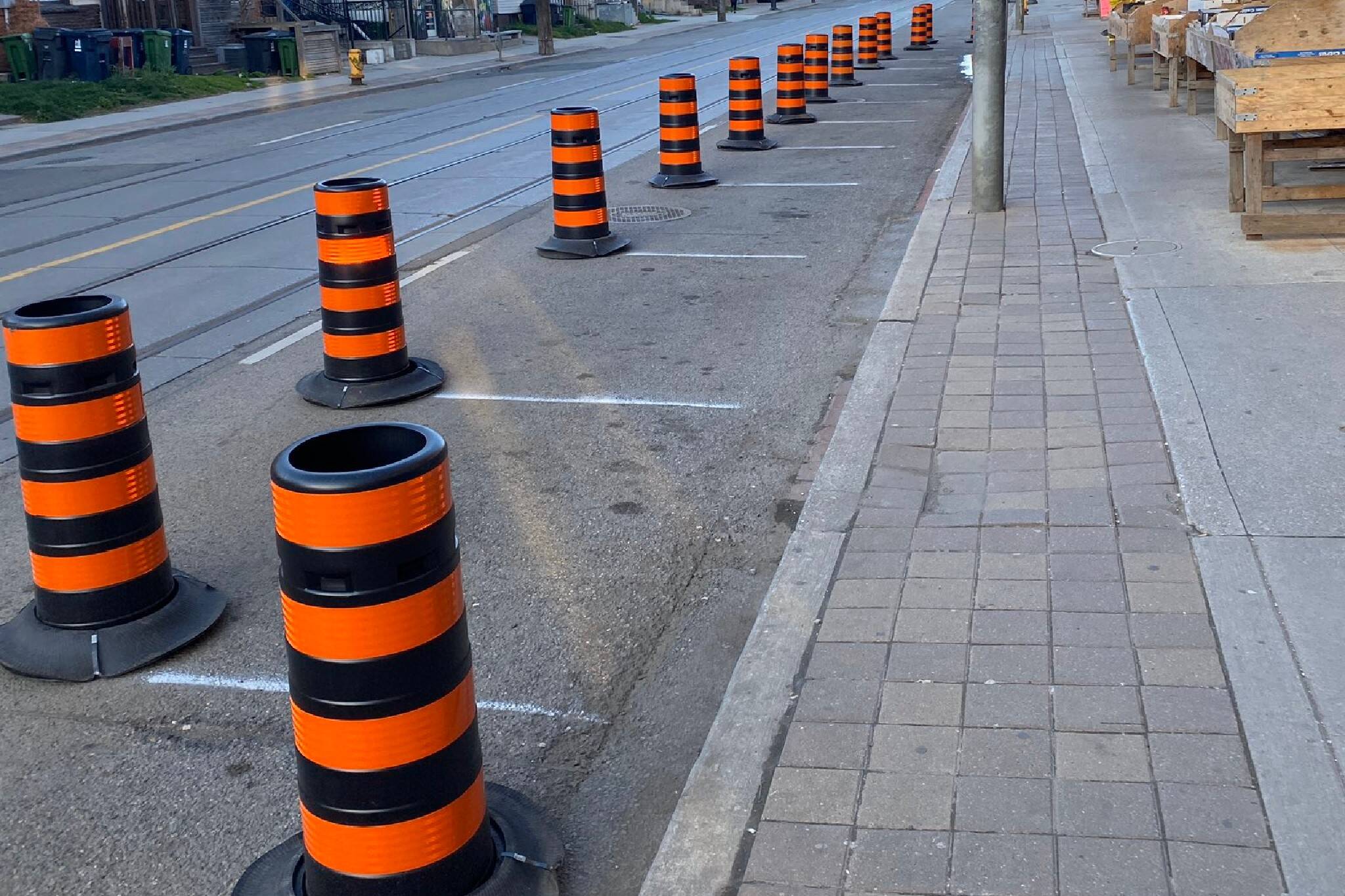
Advocates criticize Toronto's plan to make more space for pedestrians and parking
The City of Toronto launched a new program last week in order to address the lack of space for pedestrians to properly social distance on sidewalks, but advocates say the plan doesn't go nearly far enough.
When Toronto Mayor John Tory first announced the launch of CurbTO on April 27, he said it would see curb lanes blocked off in places "where there is sidewalk crowding and temporary parking concerns around essential businesses," also known as "hot spots."
The program began with 10 hot spots identified as either a Curb Lane Pedestrian Zone, Temporary Parking Pick-Up Zone or both. Curb lanes around these spots were blocked off with pylons to enable pedestrians to get around lineups outside businesses, allow drivers and delivery agents to park temporarily to expedite medicine and food pickups or both.
But critics say the program does little to actually address the issue of pedestrians lacking space to walk freely while properly physically distancing from others.
This is the entire Broadview and Gerrard #CurbTO street closure. In front of one business. The rest of the block (at the actual intersection) remains congested and it's impossible to distance from others. Do better @JohnTory and @PaulaFletcherTO. pic.twitter.com/jxPYLxl8Tp
— Michael Thompson (@MW_Thompson) May 3, 2020
Critics also say the program actually caters more to cars and businesses than it does to pedestrians, which is disappointingly on-brand for Toronto.
All the shots of #CurbTO I've seen involve access to a store. So this really isn't about pedestrians safety and more a support for shopping and the stores.
— sufferin (@DufferinRider) May 2, 2020
Photos and videos of some of the hot spots have also been shared to social media in recent days, revealing that pylons on a small stretch of a curb lane do little to address congestion on the rest of the street.
A little late to the party, but just catching up on #CurbTO — could Phase 1 be any more restrained?! Also more space for parking because, well, #Toronto
— The Corey Hotline 🏳️🌈 (@coreybrendan) May 3, 2020
Some cyclists are also unhappy with the implementation of the program as it forces them to merge with traffic when approaching a hot spot.
As a cyclist, I'm not a huge fan of the quick merge at this #CurbTO location
— Dave 🚲__⬅️2m➡️__🚲 Edwards (@DaveLikesBikes) May 2, 2020
Danforth is full is speeding drivers, I don't want to merge with them
I appreciate the attempt, but a lane closure with a temp bike lane and wider sidewalks seems like a better idea#streets4peopleTO pic.twitter.com/OxUplQrRUd
City councillor Kristyn Wong-Tam and other advocates have repeatedly called on the city to close some downtown streets to cars so that pedestrians can properly spread out, and they maintain that this is the only effective way to ensure social distancing while allowing residents to go outside for fresh air and exercise.
I first asked about opening streets to give residents more space for physical distancing on March 23. Over a month later, today #CurbTO is announced, giving pedestrians a sliver more space (not what I asked for) and it comes with expanded parking. 🤔
— Kristyn Wong-Tam (@kristynwongtam) April 28, 2020
https://t.co/tkm103SGxf
Still, the city plans to expand the CurbTO program. Businesses, BIAs, residents and city councillors can submit requests to have particularly busy spots considered for it, and councillor Joe Cressy submitted 13 spots for consideration just yesterday.
Safe streets are an essential part of any city. As the CurbTO program expands, my team and I have reached out to Ward 10 residents and organizations to suggest locations where Curb Lane Pedestrian zones are needed to create enough space for physical distancing on our sidewalks. pic.twitter.com/3e3VEJbIZL
— Joe Cressy (@joe_cressy) May 3, 2020
But while some are willing to accept the bare minimum, others continue to demand more.
"We need to close streets – partly or entirely – to give people more room to circulate safely, especially in large urban centres. We need to let people use parks to their full extent – enough of this 'stay on the path or be fined' nonsense," wrote Globe and Mail health columnist Andre Picard in an article earlier today.
The Toronto Star even published an editorial on the matter titled Toronto needs to make space and trust residents to go for a walk last week.
And in Toronto we have #CurbTO going into 10 hotspots. It probably doesn’t even add up to 1 mile of extra space for pedestrians.
— Kristyn Wong-Tam (@kristynwongtam) April 28, 2020
NYC to Close 40 Miles of Streets to Give Walkers More Space https://t.co/ytGAhAGZAM
Other urban centres, such as New York City, have moved to close countless major streets to make space for people.
If the most populous city in the U.S. can do it, why can't we?
Latest Videos
Latest Videos
Join the conversation Load comments







